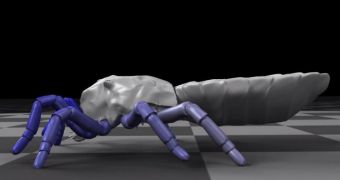Having analyzed several fossilized remains of an ancient arachnid, researchers with the University of Manchester in the United Kingdom and the Museum für Naturkunde in Germany managed to make this long-lost creature walk again.
Before those suffering from arachnophobia book themselves a flight to Mars or get to work building an atomic shelter for them to hide in, it must be said that the ancient arachnid was not made to walk in a Lazarus-meets-Jesus sort of way.
On the contrary, what the scientists behind this research project did was to use information obtained by studying the long-lost creature's fossilized remains to piece together a video showing the arachnid move in virtual space.
The video, available below, is believed to be an accurate representation of how the arachnid, which roamed the Earth about 300 to 400 million years ago, used its multiple limbs to navigate its surroundings and go in search of prey.
In a paper published in the Journal of Paleontology this past July 8, the University of Manchester and the Museum für Naturkunde scientists explain that, to create this video, they looked at 410-million-year-old fossils at the Natural History Museum in London.
In order to establish how this ancient arachnid moved about its environment, the researchers focused on the anatomy of its limbs, and tried to determine the range of motion for the animal's multiple feet. Besides, they compared this information to data obtained while studying modern spiders.
According to Phys Org, the data was eventually fed into a computer, and an open source computer graphic program dubbed Blender served to piece together a virtual representation of the ancient arachnid and its style of walking.
Interestingly enough, evidence indicates that, at the time they walked the Earth, such arachnids were top predators. In fact, researchers have reasons to believe that they were among the first predators ever to walk on land.
“When it comes to early life on land, long before our ancestors came out of the sea, these early arachnids were top dog of the food chain,” explains study author Dr. Russell Garwood, a paleontologist in the University of Manchester's School of Earth, Atmospheric and Environmental Sciences.
“They are now extinct, but from about 300 to 400 million years ago, seem to have been more widespread than spiders. Now we can use the tools of computer graphics to better understand and recreate how they might have moved – all from thin slivers of rock, showing the joints in their legs,” the researcher adds.

 14 DAY TRIAL //
14 DAY TRIAL // 